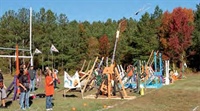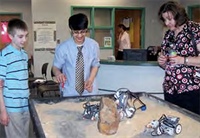Carl Sagan once said, “We can do science, and with it we can improve our lives.”
Yes, science is an action—something we can do—and it is apparent that we in education have forgotten that fact. As a result, our world ranking in science has reached an all-time low. Now with the recent push to improve our reputation, STEM (science, technology, engineering, and mathematics) has been given the lion’s share of the attention and funding as a way to help dig ourselves out.
Can it be done? How? What does it look like? A team of dedicated and forward thinking teachers are doing it in Salisbury, Maryland. We hope Carl would be proud.
The Salisbury Middle School STEM program has been in place for three years and serves 90 students: 30 in each grade level (6–8). The STEM program includes three core subjects (science, reading/language arts, history), technology education, and computer science. Math is incorporated throughout the STEM program; however, because of the various levels of math courses our students take, we are unable to have a “dedicated” math teacher within the program.
The STEM program is an inclusive “school within a school.” The students are selected based on an interest form they submit along with a blind written essay about the role of STEM education. Student interest in STEM is crucial; students who do not have a true interest and apply only to be included may not succeed because of the high level of emphasis on science throughout the program’s curriculum.
 Away it goes! Students built trebuchets for punkin chunkin. Photo by J. Seay.
Away it goes! Students built trebuchets for punkin chunkin. Photo by J. Seay.
Students who are selected for the program loop with the STEM teachers and their classmates for all three years of middle school. This practice of looping helps maintain the high level of expectation and rigor throughout the program. Consequently, the need to set rules, expectations, and procedures disappears after the students’ initial year in the program.
Implementing a STEM Focus
Students take the core courses of science, history, reading/language arts, and math for the entire year. Math and reading/language arts are offered in 90-minute blocks and science and history are offered in 45–90 minute single or double blocks. Students also take technology education (engineering) and computer science. In sixth grade, students take computer science every other day for a full year and tech ed every day for half the year. In seventh grade, the pattern is reversed—tech ed every other day for the full year and computer science every day for half the year. Eighth graders repeat the sixth grade configuration.
The importance of reading to be informed and to engage with the units of study is considered one of the essential pieces of the STEM program. Students read texts and novels that are relevant to their topics of study in science to help “make the connection.”
Novels include Hoot, Flush, Scat (environmental science), Fever 1793 (microbiology), Phineas Gage (biology), Double Identity (genetics), Cryptid Hunters (Geologic History), The City of Ember (physics, electricity), Super Human (Physics), Every Soul a Star (Astronomy), Life as We Knew It , The Dead and the Gone, and This World We Live In (Earth/Space/ Astronomy).
Student coursework is focused on STEM, yet students have the opportunity to take electives throughout their three years in the program, including foreign language, art, band, chorus, and family consumer science. Students also take physical education and health every other day all year.
This schedule allows the students to develop a strong background in engineering and computer programming but also lets them explore electives without sacrificing the core components of the program.
The unique “school within a school” team design of the STEM program allows for flexible grouping of students between classes. Students are able to see the interconnectedness of all areas of study as they relate to an essential problem or question. Students create projects that have ties to the community, which helps solidify the importance of STEM as a powerful educational experience.
The STEM program at Salisbury Middle School, funded primarily through grants, has been able to obtain key resources that help the team develop high-interest, high-rigor problem-based units. Resources include LEGO Mindstorms, LEGO renewable energy packs, a class set of netbooks, a class set of iPods, GPS units, smart pens, a greenhouse, and gardens.
How It’s Different
 Students created their own “transformers.” These are the Rodinia Rovers. Photo by C. Pavlekovich.
Students created their own “transformers.” These are the Rodinia Rovers. Photo by C. Pavlekovich.
Our program fits neatly with the Next Generation Science Standards and the Common Core State Standards, which emphasize science and engineering practices as well as reading and writing comprehension and skills through engagement with content.
The curriculum is based on the current Maryland Educational Standards; the difference is the thematic problem-based approach to covering the content. Unit design within the program is driven by the grade-level science curriculum.
The team plans the units around an overarching question or problem that meets the following criteria:
- The problem is valid.
- Students can relate to the problem.
- There can be multiple paths to a solution.
- The problem can be applied to the various classes to truly integrate the unit across the grade-level curriculum.
The team has developed one seventh grade unit around the study of bacteria and viruses. The problem the students attempt to solve is: “How do we keep our friends from getting sick?” Students participate in brainstorming sessions to address the issue. These sessions often generate other questions that students must investigate within the unit to help clarify their misconceptions, beliefs, or doubts. By starting every unit in this way, the team is able to gauge the students’ understanding of the topic, which helps drive our instructional practices.
The lessons in this unit focus on bacteria, viruses, diseases, epidemics and pandemics, vaccinations, medications, and prevention. Lab experiments (culturing bacteria) and simulations such as The Great Flu Game, an online activity, are central to the unit, as is a role-playing simulation titled “Mystery Disease” about an E. coli outbreak at a town fair. This activity requires the students to work in teams to diagnose, treat, and prevent future outbreaks based on their experiences during the simulation. Students also play the board game Pandemic, which is another opportunity for them to learn, experience, and problem solve based on the unit’s theme.
Students continue their exploration of this topic throughout their other classes as well. In history class, they study the conditions of colonial America and the impact of poor sanitation and the lack of medical knowledge. In their reading/language arts class, they read non-fiction texts about diseases as well as the novel Fever 1793, which focuses on the yellow fever outbreak in America.
Using the background knowledge they develop from reading these texts, the students put various diseases “on trial” for crimes against humanity. Through this activity, students are exposed to the court system and expand their knowledge of the topics discussed in their science class.
Continuing with this theme in tech ed, students look at how civil engineers design towns and cities taking into consideration the possibility of something like an epidemic. It is this trans-disciplinary approach that develops a deep and rich understanding of the content.
With every unit we design, we try to include guest speakers and field trips to give the students the opportunity to engage with the content beyond the classroom. For this particular unit, we invite doctors from the local hospital who specialize in infectious diseases to speak to the students about the dangers and the risks associated with bacteria and viruses. This also is an opportunity for our guests to talk to the students about the importance of pursuing a STEM-related career.
We also had the City of Salisbury’s risk management director speak to the class about the plans that are in place should something such as an epidemic occur. The immersion of our students in this type of rich content allows them to understand in context the importance of what they are learning and how it affects not only them but also others in their community.
Immersion vs Exposure
Most teachers feel pressured to complete the curriculum and not to “waste” too much time on any one topic that doesn’t allow for much investigation. The content philosophy of a mile wide and an inch thick contrasts with our approach, which is an inch wide and a mile thick.
STEM immersion requires our STEM students to “defend” their robotic planetary rover designs (working robots) in front of the local professional and scientific community after weeks of research and engineering. This is immersion within the curriculum through interdisciplinary unit design, high levels of rigor, problem/solution applications, and continual development of 21st century skills they will need for future employment.
All students at Salisbury Middle School are exposed to STEM-related activities and curriculum. This exposure gives them the opportunity to engage in short activities that may be “canned” and may have a small reading piece to go along with a lesson. For example, when our eighth graders focus on Newton’s laws of motion, student teams design and construct Punkin Chunkin devices that are tested in a competition similar to the world-famous event that is a local tradition up the road in Delaware.
Looking Ahead
As we move forward with our program, we are planning to explore these possibilities:
Flip the classroom. The concept of flipping the classroom—using classroom time for hands-on activities rather than traditional teaching—is gaining popularity. We are using flipped classroom activities in science and want to expand the use of this instructional method to all classes.
Develop long-term problem-based units. The flexibility of having all three grade levels with one team of teachers provides opportunities to expand the idea of creating problem-based units that could span the course of the three-year program. This type of immersion allows students to be fully vested in their educational outcomes.
Expand our outdoor classroom. We want to include more student-conceived research projects and increase students’ experience with horticulture.
The success of the program cannot be possible without the support and dedication of our school’s administration, content supervisors, and teachers who have put in many hours to create, develop, enhance, enrich, and improve the educational experiences for our students. It is by no means a simple task. However, all of us who teach in the program agree that we are doing our best teaching and giving our students the best opportunities to become productive, scientifically literate citizens.
Previously published in Middle Ground magazine, August 2012